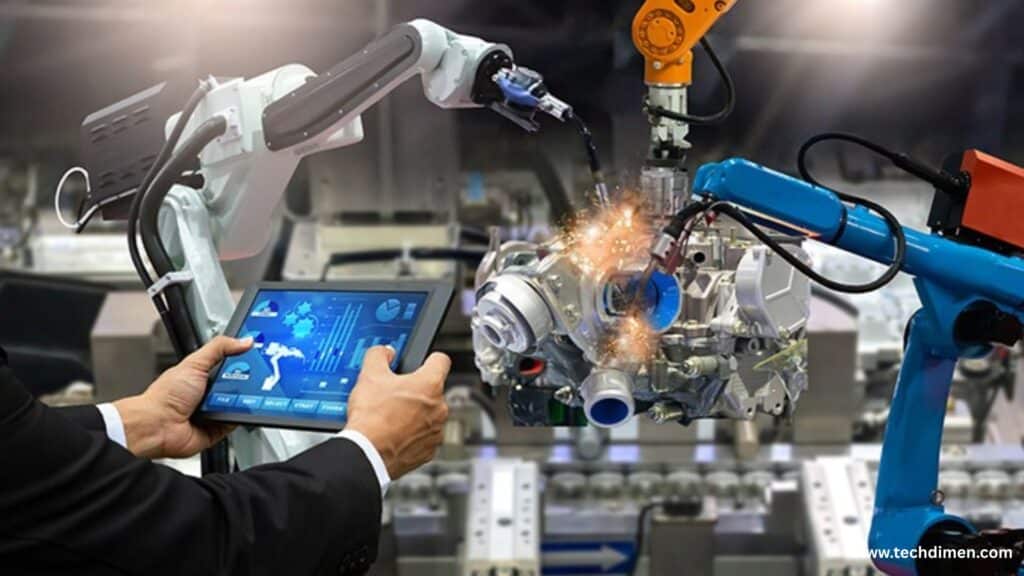Electromechanical systems engineering technology combines mechanical and electrical engineering principles to create smart, efficient, and automated solutions. This multidisciplinary field supports a wide range of technologies, from simple electric motors to advanced robotics used in aerospace, automotive, manufacturing, and consumer electronics. This article offers a clear and detailed overview of electromechanical systems engineering technology. It covers fundamental principles, key components, educational pathways, industry applications, and emerging trends.
Defining Electromechanical Systems Engineering Technology

Electromechanical systems are hybrid systems where mechanical subsystems and electrical components work together to perform physical tasks involving motion and control. These systems convert electrical energy into mechanical movement or, in some cases, mechanical energy into electrical signals. Examples include electric motors, robotic arms equipped with sensors and actuators, automated machinery in factories, and automotive systems such as power steering or braking. The defining feature of these systems is their seamless integration of mechanical design and electronic control.
At its core, electromechanical engineering involves the transformation of energy and the processing of signals. Electrical energy powers mechanical components like motors or actuators, while sensors convert physical variables such as position, pressure, or temperature into electrical signals for processing. Feedback control mechanisms then use these signals to adjust operations dynamically, ensuring precision and safety. This harmonious integration forms the foundation of mechatronics, a field that blends mechanical, electrical, computer, and control engineering.
Historically, the origins of electromechanical engineering date back to the early 1800s with the invention of relays and solenoids, which allowed electrical switching of mechanical devices. The development of the electric motor by pioneers like Michael Faraday and Nikola Tesla marked another milestone. During the Industrial Revolution, feedback control became integral for regulating steam engines and later, more advanced machinery. In recent decades, the integration of microprocessors revolutionized automation, enabling programmable control and complex system management. Now, the emergence of the Internet of Things (IoT) and artificial intelligence (AI) continues to push the boundaries of what electromechanical systems can achieve.
the Core Elements of Electromechanical Systems
To understand how electromechanical systems operate, it’s crucial to examine their fundamental components. Mechanical parts deliver the physical movement and force needed for various tasks. Actuators, such as electric motors or hydraulic cylinders, convert energy into motion. Gear systems help adjust torque and speed between parts, while linkages and levers transfer forces and alter the type of motion. Bearings and shafts support rotating elements and reduce friction, allowing smooth and efficient operation. Material choices vary by application for example, aerospace uses lightweight alloys, while industrial machines rely on heavy-duty steel for strength and durability.
On the electrical side, sensors detect physical parameters like position, pressure, or temperature, while actuators like motors and solenoids carry out mechanical commands. Power electronics, including drive circuits and inverters, control the flow of electrical power to motors and other devices. Embedded systems such as microcontrollers and programmable logic controllers (PLCs) run the control software that coordinates these components to perform as intended. Proper wiring and circuit design are essential to ensure reliable signals and safe operation.
Control systems are key to managing the performance of electromechanical systems. These systems operate as either open-loop, sending commands without feedback, or closed-loop, where sensor feedback is used to adjust operations dynamically. Closed-loop control is vital in precision applications like robotics and automation. PID controllers (Proportional-Integral-Derivative) are commonly used to maintain system stability by continuously adjusting control inputs based on feedback.
Integrating mechanical and electrical components presents several challenges. These include synchronizing mechanical movements with electronic signals, minimizing electromagnetic interference in industrial environments, and ensuring system reliability under harsh conditions. Engineers address these challenges through careful design, electromagnetic shielding, extensive testing, and ongoing maintenance to ensure that electromechanical systems remain stable and effective over the long term.
Educational and Training Framework

The field of electromechanical systems engineering technology requires a broad and interdisciplinary educational background. Typical curricula cover mechanical design principles, including computer-aided design (CAD) specific to electromechanical applications, electrical circuit theory, power electronics, control systems, and programming for embedded devices and PLCs. Hands-on laboratory work complements theory, allowing students to assemble components, simulate system dynamics using software tools like MATLAB and Simulink, and implement real-time control experiments.
Capstone projects often challenge students to integrate mechanical and electrical elements into fully functioning prototypes or automated systems, providing invaluable experience. Many programs also offer internships in industrial settings, where students apply their skills in automation, robotics, and system integration.
Accreditation from organizations such as ABET ensures that educational programs meet industry standards. Certifications in mechatronics, PLC programming, and other specialized areas enhance employability and professional credibility. Additionally, engineers must be familiar with safety and quality standards like ISO 9001 and IEC 61508, which govern the reliability and safety of electromechanical systems.
Industry Applications and Emerging Trends
Electromechanical systems find applications across a wide range of industries. In automotive engineering, electric vehicles (EVs) rely heavily on advanced motor control systems, battery management electronics, and automation in manufacturing processes. Aerospace uses precise actuators and embedded control systems in flight control surfaces and unmanned aerial vehicles (UAVs). In manufacturing, industrial robotics and smart factory setups depend on integrated electromechanical components for automation and efficiency. Consumer electronics also embed electromechanical systems in devices like smartphones and home appliances.
Current trends are driving electromechanical systems towards higher connectivity and intelligence. The incorporation of IoT technology allows devices to communicate and be monitored remotely in real time. Artificial intelligence and machine learning are increasingly used for predictive maintenance, where sensor data helps forecast failures before they occur, reducing downtime and improving efficiency. Research into nano-electromechanical systems (NEMS) promises breakthroughs in medical devices and sensors at microscopic scales. Renewable energy technologies are also incorporating electromechanical systems, such as in smart grids and energy storage solutions.
Sustainability is becoming a key consideration in system design, with engineers focusing on energy-efficient motor systems, the use of recyclable materials, and green manufacturing processes. Lifecycle management and environmental impact assessments ensure that systems are not only effective but also eco-friendly.
Professional Competencies and Career Development

Professionals in electromechanical systems engineering technology require a solid technical foundation. Mastery of CAD software for designing mechanical and electrical components is essential, along with expertise in PLC programming and ladder logic for industrial automation. Embedded systems programming, often using languages like C or C++, enables engineers to write the firmware that runs microcontrollers. Proficiency in troubleshooting with diagnostic equipment and understanding electromechanical testing protocols ensures systems operate reliably.
Soft skills are equally important. Analytical thinking allows engineers to solve complex system integration problems, while teamwork is vital as projects often require collaboration across mechanical, electrical, and software disciplines. Clear communication helps interface with clients, production teams, and management. Ethical decision-making and strict adherence to safety standards protect users and workplaces.
Given the rapid pace of technological change, lifelong learning is critical. Engineers must stay current through continuing education, attending workshops, obtaining certifications, and following developments in automation technology, control system architectures, and industrial communication protocols.
Future Outlook for Electromechanical Systems Engineering Technology
The future of electromechanical systems engineering technology is marked by increased automation and smart system integration. Systems will become more autonomous, self-diagnosing, and adaptive, combining machine vision, smart sensors, and AI to operate efficiently with minimal human intervention.
However, challenges such as cybersecurity risks in networked devices and the balance between cost and system complexity remain. Ensuring reliability in increasingly sophisticated systems will require ongoing innovation.
Research opportunities abound, particularly in the development of nano-electromechanical devices for medical diagnostics and advanced human-machine interfaces that improve user experience. Sustainability goals will drive innovation in energy-efficient and environmentally friendly electromechanical systems.
Case Study: Electromechanical Systems in Automotive Manufacturing
Tesla, Inc. offers a compelling example of electromechanical systems engineering in practice. Tesla’s electric vehicles utilize embedded microcontrollers to manage drivetrain control, motor torque, and battery systems with high precision. Their manufacturing plants employ advanced industrial robotics, controlled via PLCs, to automate assembly with exacting accuracy. Moreover, Tesla’s use of sensor data combined with AI algorithms enables predictive maintenance, maximizing uptime and reducing costs. This case highlights the seamless integration of mechanical and electrical engineering to drive innovation and efficiency.
Summary Table: Key Components of Electromechanical Systems
| Component Category | Examples | Role in System |
|---|---|---|
| Mechanical Subsystems | Gears, linkages, actuators | Provide motion and mechanical force |
| Electrical Components | Motors, sensors, power electronics | Convert energy and process signals |
| Control Systems | PLCs, microcontrollers, PID controllers | Regulate and automate system behavior |
| Software & Simulation | CAD, MATLAB, embedded programming | Design, simulate, and test systems |
FAQs
What Are Electromechanical Systems?
Electromechanical systems combine mechanical parts with electrical and electronic controls to perform tasks that involve motion and automation. These systems convert electrical energy into mechanical movement or transform mechanical inputs into electrical signals, often utilizing sensors, actuators, and control units to function efficiently.
What Skills Are Necessary for a Career in Electromechanical Systems Engineering Technology?
To succeed in this field, individuals need skills in mechanical design using CAD software, programming programmable logic controllers (PLCs) and microcontrollers, understanding electrical circuits and control systems, and troubleshooting electromechanical devices. Additionally, problem-solving abilities, effective teamwork, and a commitment to continuous learning are essential.
How Do Electromechanical Systems Differ from Purely Mechanical or Electrical Systems?
Electromechanical systems integrate both mechanical and electrical components, unlike purely mechanical or electrical systems. Mechanical subsystems provide motion and force, while electrical parts manage control, sensing, and power regulation, resulting in systems that are more precise, automated, and adaptable.
Which Industries Use Electromechanical Systems Engineering Technology?
Industries such as automotive manufacturing, aerospace, industrial automation, robotics, consumer electronics, and renewable energy heavily depend on electromechanical systems to build efficient, reliable, and intelligent machines.
What Educational Background Is Required for Electromechanical Systems Engineering Technology?
Typically, professionals hold degrees in electromechanical engineering technology, mechanical engineering technology, electrical engineering technology, or mechatronics. The education includes mechanical design, electrical circuit theory, control systems, embedded programming, and hands-on labs.
What Role Do Programmable Logic Controllers (PLCs) Play in Electromechanical Systems?
PLCs act as industrial controllers that automate machinery by processing input signals from sensors and sending commands to actuators. They enable real-time, programmable control of manufacturing and automation processes.
Why Is Automation Important in Electromechanical Systems?
Automation increases efficiency, accuracy, and safety by allowing systems to operate continuously with minimal human intervention. This reduces operational costs, minimizes errors, and enhances productivity in various applications.
What Challenges Are Common in Designing Electromechanical Systems?
Design challenges include handling electromagnetic interference, synchronizing mechanical movements with electronic controls, ensuring system reliability, safety compliance, and integrating components from multiple engineering disciplines.
How Is Sustainability Addressed in Electromechanical System Design?
Sustainable design focuses on energy-efficient components, recyclable materials, longer system lifespans, and adherence to environmental standards to minimize the ecological impact of electromechanical systems.
What Are the Emerging Trends in Electromechanical Systems Engineering Technology?
Key trends include the integration of AI and machine learning for predictive maintenance, IoT-enabled remote monitoring, advancements in nano-electromechanical systems (NEMS), and growth in smart manufacturing and robotics technologies.
Final Thought
Electromechanical systems engineering technology is at the heart of today’s most innovative and efficient machines, seamlessly blending mechanical design with electrical control. As industries push toward smarter automation and interconnected systems, this field plays a crucial role in developing solutions that improve productivity, precision, and reliability. The ongoing advances in technologies like IoT, artificial intelligence, and sustainable engineering will continue to shape the future, making expertise in electromechanical systems more important than ever. For professionals in this area, staying curious and adaptable is key to unlocking new possibilities and driving progress in an increasingly automated world.

Jhon AJS is a tech enthusiast and author at Tech Dimen, where he explores the latest trends in technology and TV dimensions. With a passion for simplifying complex topics, Jhon aims to make tech accessible and engaging for readers of all levels.







